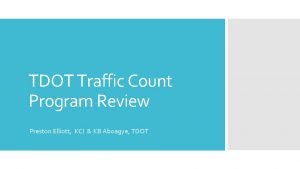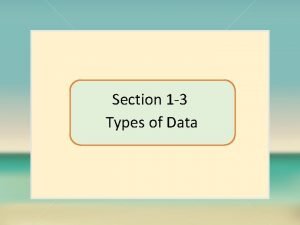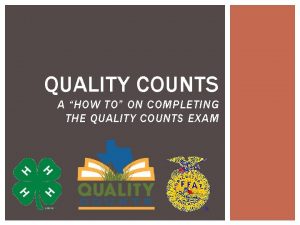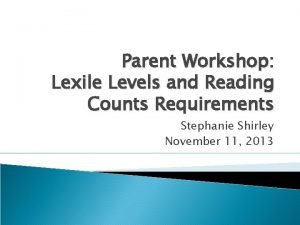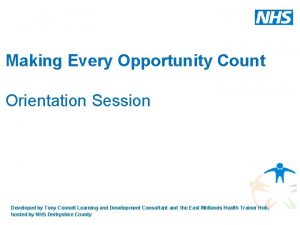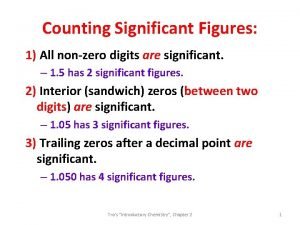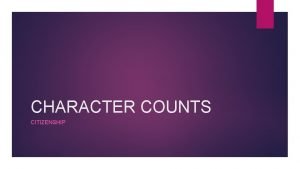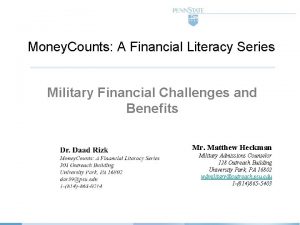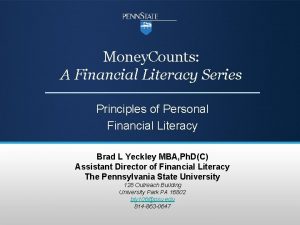Money Counts A Financial Literacy Series Financial Literacy






































- Slides: 38

Money. Counts: A Financial Literacy Series Financial Literacy for Women Dr. Daad Rizk Money. Counts: A Financial Literacy Series 301 Outreach Building University Park PA 16802 dar 39@psu. edu 814 -863 -0214

Learning Objectives • Define financial literacy for women • Identify what women really need – Understand financial challenges unique to women – Identify possible solutions through education and social awareness – Design a specific curriculum to educate women in financial literacy Money. Counts: A Financial Literacy Series

Poll • What is your gender and age? – I am a female between the ages of 25– 54. – I am a female younger than 25. – I am a female older than 54. – I am not a female. Money. Counts: A Financial Literacy Series

Women in the United States • • Total population in the U. S. = 317 million (men, women, children) Women in the U. S. = 161 million (51% of total population) Women in the workforce = 73 million (45% of total women) Women not in the workforce = 88 million (55% of total women) • 26% of women in the U. S. do not work (ages 25– 54) – No income – No savings – No retirement plan Source: U. S. Bureau of Labor Statistics (BLS), Current Population Survey (CPS)/ Graph by the Women’s Bureau, U. S. Department of Labor Money. Counts: A Financial Literacy Series

Financial Literacy for Women Financial literacy is a serious issue facing women in the United States (and globally) Women earn less over a lifetime Women spend more than 11– 13 years out of work Women save and invest little, if any Women acquire same or higher debts Women end up divorced (50%) Women live longer (5– 7 years) Women end up with little if any “nest egg” Women fear “bag lady” syndrome Money. Counts: A Financial Literacy Series

Poll • Are you using student loans to finance your education? – I am a female student, and I am borrowing the full eligibility in student loans to finance my education. – I am a female graduate, and I have borrowed the full eligibility in student loans to finance my education. Money. Counts: A Financial Literacy Series

College Graduates and Debt Money. Counts: A Financial Literacy Series

Student Loans • Total U. S. student loans: $1, 066, 029, (T) – Average loan for college graduate = $27, 000 – Women college graduates are carrying 60% of student debts • Average loan monthly payment is between 8– 20% of women’s net income » U. S. Debt Clock. org Money. Counts: A Financial Literacy Series

Poll • How do you handle credit cards? – I use credit cards, and I carry a balance on each of them. – I use credit cards, but I pay them on time and in full each month. – I do not use credit cards, because I hate being in debt. Money. Counts: A Financial Literacy Series

Credit Card Debt • Total U. S. credit card debt = $867, 784, (B) • Average credit card debt = $5, 600 – FINRA (Financial Industry Regulatory Authority, Inc. ) 2009 study of 28, 000 people: – – Carrying a credit card balance: 55% of men, 60% of women Making only minimum payment: 38% of men, 42% of women Paying a late fee: 23% of men, 29% of women Over-the-limit fee: 15% of men, 16% of women Money. Counts: A Financial Literacy Series

Average per Year = 1 Million Civilian labor force by sex, 1970– 2012 Money. Counts: A Financial Literacy Series

Poll • What type of job is ideal for you? – A “Pink Collar Job” – A “White Collar Job” – A “Blue Collar Job” – A “Job”—I don’t care what type Money. Counts: A Financial Literacy Series

“Pink Collar” Jobs Women as a percentage of total employed in selected occupations, 1985– 2012 annual averages Money. Counts: A Financial Literacy Series

45% Are 45 or Older Money. Counts: A Financial Literacy Series

Women’s Earnings Women’s earnings as a percent of white men’s, by race, full-time wage and salary workers, 1980– 2012 annual averages Money. Counts: A Financial Literacy Series

Are All Women Equal? Money. Counts: A Financial Literacy Series

Poll • How are you raising, or will you raise, your family? – I am a stay-at-home mother. – I plan to stay home to raise my family. – I plan to keep my job while raising my family. – I plan to work from home while raising my family – self-employed. Money. Counts: A Financial Literacy Series

The Lost Years • Women spend, on average, 13 years out of work – Maternity and family reasons – Care of elderly – Effect on retirement – Effect on Social Security – Effect on savings and investing Money. Counts: A Financial Literacy Series

Ladies Last! 5– 7 Years Average Gap Money. Counts: A Financial Literacy Series

Wo-------------Men Women • Earns. 83 cents • Work an average of 27 years • The average woman can expect to live to 80. 1 years old • In 2004, the median income for retired women was $12, 080 • 60% of U. S. college students • 38% in management positions • Women with college degree earn $35, 296 • Women think of income as family income • Women spend small amount of money on many little things – clothes, shoes, beauty supplies, children’s needs, daily home expenses • Women see themselves as savers Men • Earns $1. 00 • Work an average of 40 years • The average man can expect to live to 74. 8 years old • In 2004, the median income for retired men was $21, 102 • 40% of U. S. college students • 55% in management positions • Men with college degree earn $42, 918 • Men think of income as men’s income • Men spend large amount of money on bigitem things – boats, hobbies, cars, houses; men tend to depend on women to take care of daily money matters • Men see themselves as investors Money. Counts: A Financial Literacy Series

Young, Fabulous, and Broke! • Women tend to spend more than men on: – appearance at work and in general – safety and security – safer cars, family-friendly homes and neighborhoods – charity and gifts – volunteer activities, social activities, family and friend obligations Money. Counts: A Financial Literacy Series

Poll • Who is the breadwinner in your family? – I am a single mother and the breadwinner in my family. – I am married and the breadwinner in our family. – I am married, but my husband is the breadwinner in our family. Money. Counts: A Financial Literacy Series

Moms as Breadwinners • 10 million Mother as the Sole or Primary Provider: 1960– 2011 Money. Counts: A Financial Literacy Series

26% Single with Children Money. Counts: A Financial Literacy Series

Social Security Is Neutral with Respect to Gender • Women represent 56% of all Social Security beneficiaries age 62 and older, and approximately 68% of beneficiaries age 85 and older. • In 2011, 48% of all elderly unmarried females receiving Social Security benefits relied on Social Security for 90% or more of their income. • In 2011, the median earnings of working-age women who worked full-time, year-round, were $36, 500, compared to $48, 000 for men. Can we do better? Money. Counts: A Financial Literacy Series

“Bag Lady Syndrome” Money. Counts: A Financial Literacy Series

Poll • Who makes financial decisions in your family? – My partner makes most of the financial decisions. – My partner and I make decisions together. – I am single, and I make all the financial decisions. – I am married, and I make most of the financial decisions. Money. Counts: A Financial Literacy Series

Education and Empowerment! • Educate yourself about money management and investing – Do not rely on someone else for your financial security • Husband, boyfriend, father • Get more education/training – Aim for self-improvement at work – Keep moving ahead in your career – Break the traditional feminine career track Money. Counts: A Financial Literacy Series

Set Smart Goals! • Set SMART goals – it’s key to financial success – S = Specific – M = Measurable – A = Attainable – R = Realistic – T = Timely • Build a solid financial plan – Assign a $ amount to each goal and work toward it! – Build a solid budget Money. Counts: A Financial Literacy Series

Build an Emergency Fund! • Build an emergency fund – At least 3 month’s worth of expenses – Increase to 6 months after you pay off all debts • Credit card debts • Student loans • Car loans • Other loans • Be involved in the day-to-day management of your family’s finances, and talk about money with your spouse and children Money. Counts: A Financial Literacy Series

Needs Versus Wants • Make yourself feel good with things that promote self-respect and creativity, without spending money – Shopping is not therapy! – Assess needs versus wants – Re-examine your belief and value system about money • Spend less than you earn – the secret to financial security and success! – Create a balanced budget – at least 10% of net income should be in savings – Assess ways to increase income – Explore ways to reduce spending and waste • Assess your partner’s or spouse’s debt when you marry – Make a family financial plan – Share sacrifices for the family – Evaluate good debts from bad debts Money. Counts: A Financial Literacy Series

Put Your Name on It! • Don't let the fear of losing money, fear of failure, or fear of the unknown stop you from investing – Buy your own home – Buy your own car – Have an emergency savings account in your name – emergency fund – Establish your own credit worthiness (credit cards and debt management) • Be financially independent – Invest in your retirement – Have a credit card in your name – keep it paid in full monthly – Protect your financial reputation – Protect your identity – Be your own Knight in Shining Armor! • A man is not a financial plan! Money. Counts: A Financial Literacy Series

Examine Your Lifestyle • • • What type of house do you want to live in? Where do you want to live? What kind of a career do you want? How much do you need to earn to live there? What type of people do you want to work with? Figure out what you really want out of life, because you become what you think about. • Invest time to know yourself and your lifestyle; it will help you set your goals and set a budget to reach those goals. Money. Counts: A Financial Literacy Series

Start Work Young and Research Your Marketplace! • Start work young: There is evidence that starting work young can boost confidence. Whether your first job is pumping gas, bagging groceries, or filing, the discipline of work trains the mind to focus. A first paycheck is a great motivator – you quickly learn the link between work and money! • Do the research and find out the value of your contribution to the marketplace. From there, ask for this amount and do not settle for less. Value your own work and efforts, whether you are an engineer or an artist. • Reach for the highest education, specialization, certification, and credentials you need to achieve your dreams. Money. Counts: A Financial Literacy Series

Evaluate Your Attitude Toward Money! • Treat money as the exchange tool you need to achieve your goals • Invest first – spend second • Make your money work for you – work hard for your money • Keep a low debt ratio to income – Monthly payment (full) should not exceed 10% of your net monthly income • Includes all debts except mortgage Money. Counts: A Financial Literacy Series

Top Financial Mistakes Women Make • • Let husband or partner manage the money without their involvement Sign income tax return without understanding or reading it Not taking into account women’s greater longevity Not asking enough financial questions Not sharing care of children and elderly with their partners Not having their own savings, checking, debit and credit cards Not preparing for long-term financial decisions In divorce, women tend to keep the mortgage instead of pension or retirement income • In divorce, women tend to fail to identify debts, credit cards • Fail to protect against future assets, change of will, beneficiaries Money. Counts: A Financial Literacy Series

What Can Women Do Collectively? Advocate for Women: • to receive the pay they deserve and equal work conditions • to have access to higher-paying jobs • for women in the workforce to have affordable child and elder care, as well as access to quality flexible work and paid family leave • to receive the support they need through expanded tax credits to help meet the costs of raising their families Money. Counts: A Financial Literacy Series

Money. Counts: A Financial Literacy Series Thank You! Comments and Questions Dr. Daad Rizk Money. Counts: A Financial Literacy Series 301 Outreach Building University Park PA 16802 dar 39@psu. edu 814 -863 -0214
 Money money money team
Money money money team Symbols in the great gatsby
Symbols in the great gatsby Money smart money match
Money smart money match Money on money multiple
Money on money multiple The great gatsby historical context
The great gatsby historical context How is daisy described in the great gatsby
How is daisy described in the great gatsby Media literacy venn diagram
Media literacy venn diagram 3 basic components of media and information literacy
3 basic components of media and information literacy Differentiate people as media and people in media
Differentiate people as media and people in media Cyber literacy and digital literacy
Cyber literacy and digital literacy Maclaurin series vs taylor series
Maclaurin series vs taylor series Balmer series lyman series
Balmer series lyman series Maclaurin expansion
Maclaurin expansion Deret maclaurin
Deret maclaurin Ibm p series vs i series
Ibm p series vs i series Series mixing in feedback amplifier represents
Series mixing in feedback amplifier represents Series aiding and series opposing
Series aiding and series opposing Arithmetic series vs geometric series
Arithmetic series vs geometric series Steve ward calm counts
Steve ward calm counts Tdot traffic count
Tdot traffic count Cage questionnaire
Cage questionnaire It consists of numbers representing counts or measurements
It consists of numbers representing counts or measurements Quality counts background checks
Quality counts background checks Cry unit
Cry unit Sri reading counts
Sri reading counts Bias through source control
Bias through source control Every opportunity counts
Every opportunity counts Making opportunity count
Making opportunity count Bias by photos, captions and camera angles
Bias by photos, captions and camera angles Glasgow counts
Glasgow counts Significant figures chemistry
Significant figures chemistry Mathcounts preparation book
Mathcounts preparation book Semcog traffic counts
Semcog traffic counts Calendar math kit
Calendar math kit Character counts citizenship
Character counts citizenship Skip counting number lines
Skip counting number lines Bias through statistics and crowd counts examples
Bias through statistics and crowd counts examples Trrfcc character counts
Trrfcc character counts Fdot psee
Fdot psee



















